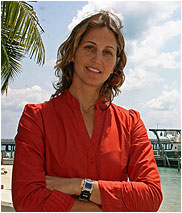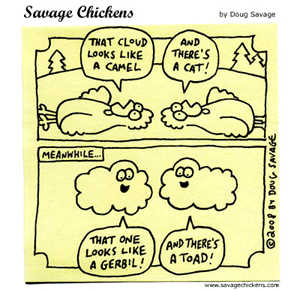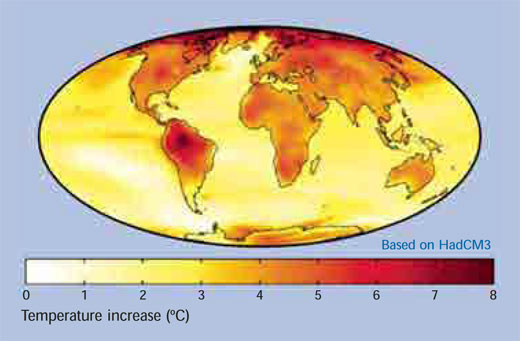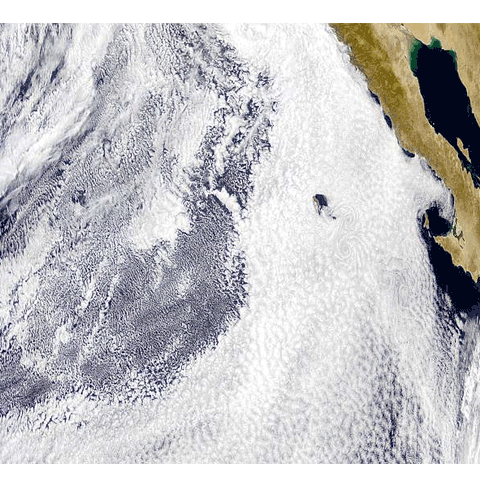Science news - clouds and climate change
23-July-2009 14:00 ET
Consulting with clouds
One of the biggest questions in climate change is this: What are the clouds going to do?
It's a question Amy Clement and colleagues have been investigating in detail. Why? Well clouds might slow down climate change or they could speed it up. It depends what happens to them as greenhouse gases warm the Earth. There are two possibilities.:

It might get cloudier. If it does then those extra clouds will block some of the energy from the sun and the Earth won't warm as quickly.
Or it could get less cloudy. That would let more energy from the sun through, which would make the warming worse, which would produce even less clouds .... and round and round in a positive feedback that we don't want at all.
News not good
Now Clement and Robert Burgman from the University of Miami's Rosenstiel School of Marine and Atmospheric Science, together with Joel Norris from Scripps Institution of Oceanography at UC San Diego, have looked in detail at the question of the clouds. Their research is published in the July 24 issue of Science.
And the answer they've found is not good news.

Clement and her colleagues have been studying observations of clouds in the northeast Pacific, made over the past 50 years. This is one of the best-studied areas of low-level clouds in the world.
Surface or space
But that doesn't mean they had an easy time of it. Why? Well there are two different ways to gather information about clouds - satellite instruments and the human eye - and both have their problems, say the scientists.
With the human eye it's the "subjective nature of the measurements and sparse sampling for large regions of the ocean."
With the satellite measurements it's "spurious trends related to instrument drift and calibration" - as well as the fact that data are available only for the past 25 years.
So the scientists had to do a great deal of digging in the data, a whole heap of statistical analysis and a big bunch of checking out ideas and exploring measurements to look for real patterns, if there were any.
Surprise
The outcome of all this was a big surprise. The totally different sets of measurements were telling the same story. "The agreement we found between the surface-based observations and the satellite data was almost shocking," says Clement, the University of Miami professor of meteorology and physical oceanography, and winner of the American Geophysical Union's 2007 Macelwane Award for her work on climate change.
"These are subtle changes that take place over decades. It is extremely encouraging that a satellite passing miles above the earth would document the same thing as sailors looking up at a cloudy sky from the deck of a ship."
And what is this "same thing"?
That warming oceans produce less clouds above them.

Climate models
Most climate models don't produce this observed cloud behaviour. Only the Hadley Centre model at the UK Met Office was able to reproduce the observations, the researchers found.
"We have a long way to go in getting the models right, but the Hadley Centre model results point us in the right direction," says co-author Burgman, a research scientist at the University of Miami.
Taken together, the observations and the Hadley Centre results provide evidence that there will be fewer low-level clouds, which shield Earth from the sun's radiation, as the climate gets warmer.
This will allow the oceans to heat up, which will then cause fewer clouds, which will let more energy through, which will allow the oceans to heat up even more. Positive feedback. Increased global warming. The clouds are not going to save us
"This is somewhat of a vicious cycle, potentially exacerbating global warming," said Clement. "But these findings provide a new way of looking at cloud changes.This can help improve the simulation of clouds in climate models, which will lead to more accurate projections of future climate changes. "
More help with words
| average | evidence | mathematical model | orbits | particle | process | tropics |
What's it all about?
- What's a big question in climate change?
- As greenhouse gases warm the Earth it might get --------.
- Or it could get less ------.
- If it gets cloudier what will the extra clouds do?
- If it gets less cloudy what will that do to the energy from the sun?
- What would happen then?
- What two ways are used to gather information about clouds?
- What is the problem with the human eye. (Try to use your own words or those in the pop-up meanings, rather than those in the story itself.)
- What is the problem with satellite measurements. (Try to use your own words or those in the pop-up meanings rather than those in the story itself.)
- What did they have to do with all the data?
- Why did the close agreement between the sets of data surprise them?
- What is the main finding of all this research?
- Which was the only climate model that gave this result?
- So will the clouds make global warming go faster or more slowly?
- If you were a member of the research team think of one question you would still like to answer about all this.
- How would you make a start in trying to answer it?


